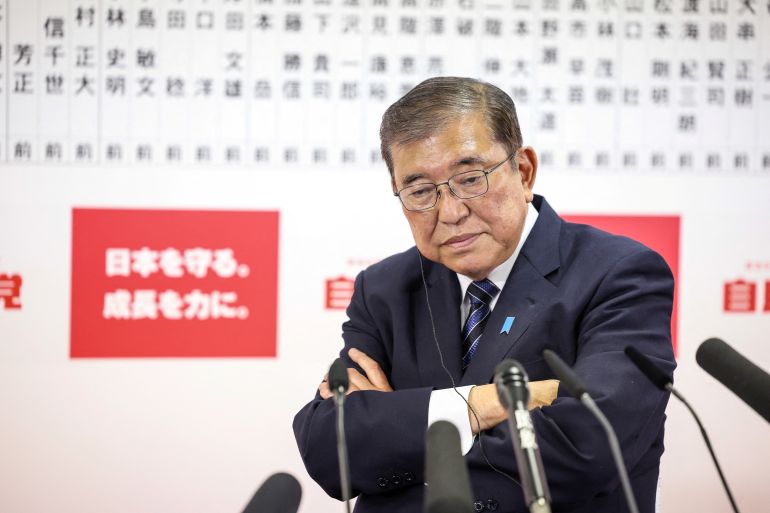Japan’s ruling coalition loses majority in blow to new PM Ishiba
The outcome is a serious blow for PM Ishiba as his Liberal Democratic Party suffers its worst result in 15 years.
Japan’s Prime Minister Shigeru Ishiba speaks to media at the Liberal Democratic Party’s headquarters in Tokyo, Japan [Takashi Aoyama/Pool via Reuters]Published On 27 Oct 202427 Oct 2024
Japan’s ruling coalition has lost its parliamentary majority in a significant defeat at Sunday’s national election, raising uncertainty about the next government’s make-up and the outlook for the world’s fourth-largest economy.
With all but 20 of the 465 seats accounted for, Prime Minister Shigeru Ishiba’s Liberal Democratic Party (LDP), which has ruled Japan for almost all of its post-war history, and junior coalition partner Komeito took 209 seats in the lower house of parliament, Japanese public broadcaster NHK reported.
That was down from the 279 seats they previously held, marking the coalition’s worst election result since briefly losing power in 2009.
“This election has been very tough for us,” a sombre-looking Ishiba told TV Tokyo.
Keiichi Ishii, who became the new leader of Komeito- the LDP’s long-term coalition partner – lost in his district last month.
The biggest winner of the night, the main opposition Constitutional Democratic Party of Japan (CDPJ), had 143 seats so far, up from 98 previously, as voters punished Ishiba’s party over a funding scandal and inflation.
The outcome may force parties into fractious power-sharing deals to rule, potentially leading to political instability as the country faces economic challenges and a tense security situation in East Asia.
“This is not the end, but the beginning,” CDPJ leader Yoshihiko Noda told a press conference, adding that his party would work with other opposition parties to aim for a change of government.
Prime Minister Ishiba said he would wait until the final results, expected in the early hours of Monday, before considering potential coalitions or other power-sharing deals.
Last month, Ishiba defeated eight other candidates to become head of the conservative LDP, which has governed Japan almost uninterrupted for seven decades, albeit with frequent changes of leader.
He took office days later, replacing Fumio Kishida, who faced discontent over rising prices, a slush fund scandal and LDP ties to a Christian movement in the wake of the 2022 assassination of former Prime Minister Shinzo Abe.
Ishiba called the snap election immediately after being elected, hoping to win a public mandate for his premiership.
Japan’s Prime Minister Shigeru Ishiba, fourth from left, and the party’s senior members stand in front of the LDP candidates’ names at the party’s HQ in Tokyo, Japan [Takashi Aoyama/Pool Photo via AP Photo]
At a rally on Saturday, Ishiba pledged that the LDP would “start afresh as a fair, just and sincere party”.
It wasn’t enough to convince voters.
The LDP has held an outright majority since it returned to power in 2012 after a brief spell of opposition rule. It also lost power briefly in 1993, when a coalition of seven opposition parties formed a government that lasted less than a year.
Smaller parties, such as the Democratic Party for the People (DPP) or the Japan Innovation Party, could now prove key to forming a government.
The DPP has 27 seats so far, and the Japan Innovation Party has 35 seats, according to NHK. But both propose policies at odds with the LDP line.
